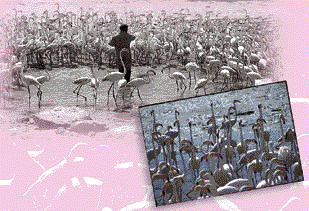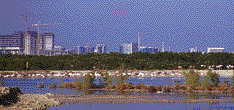 |
|
||||||||||||||||||||||||
 |
||||||||||||||||||||||||
|
Every morning around half past nine is happy hour at the creek.
Hundreds of flamingoes gather at several feeding stations spread
around the edges of the mudflats to get their portion of the designer
food made for them by the Zabeel feed plant. This morning I have the plesure of seeing the birds up close -
an opportunity arranged for me by the person responsible for the
management of the Khor Dubai nature reserve, Kevin Hyland. I joined
on of his workers in his pickup to drive down to the jetty that
is one of the feeding stations. The birds are used to this car and
are not at all disturbed at our approach. The keeper unloads three
large bags of the flamingo pellets. It is meant to be a supplement
to the natural food that the birds extract from the waters of the
creek.
The keeper has been trained well - I notice that he carefully tucks
away the string that bound the sacks and that the empty sacks are
weighed down by a rock until they are gathered to be taken back
in the truck so that they cannot be blown away by the wind. Dubai creek has been a protected area for many years now. The first signs restricting recreational activities along the top of the creek went up in the mid-eighties. Then a boom was placed across the creek just beyond the water skiing club to prevent boats and skiers from entering the sensitive area preferred by wildlife. Now a fence is being erected to give even more protection to the thousands of birds that visit, feed and breed in the reserve. In years past, I used to walk along the edge of the creek every day of the week. It was a wonderful place to get away from the hustle and bustle of the city, to breathe some clean air and feast your eyes on the sparkling blue water and the many species of birds going about their business on or near the water. Walks like this are no longer possible. The disturbance caused by fishermen, bathers, skiers and speedboat drivers spoiled the fun for the less intrusive pedestrians and bird watchers. The area is now off limits for everyone except those with special permits. But if that means that the birds have a better chance to survive and prosper, then it is a good thing. Dubai creek is famous among bird watchers. During the migration months (September-October and February-March) many thousands of wading birds spend some time on its peaceful waters. At any time in the winter months many tens of thousands of birds can be observed on the inter-tidal flats, depending on which group of migrating birds arrives on their way through. At times the numbers reach about sixty birds per hectare, a higher count than found anywhere else in the world.
Kentish Plovers (Charadrius alexandrius) breed on open stretches
of rubble, well nigh invisible with their mottled plumage. When
Kevin pointed out one of these camouflaged nesting birds to me,
I remarked that I had once seen a baby plover - the cutest little
fluffy pingpong ball on small stilts - run for cover among the bushes. On one side of the area a mud dam has been constructed to retain water in a semi-artificial pond, where the birds can stay even if the tide is out. As we drive along this pond, we notice some municipality workers on the far side, standing in the water. Undoubtedly this is a disturbance to the birds, so we drive around and along the mud dam to investigate what they are doing there. It turns out that they are from the Pest control sections and that they have been putting out rattraps among the mangroves. Apparently this muddy work necessitated ablutions. The guys were told in no uncertain terms that cleaning would have to be done elsewhere and not in the middle of the nature reserve at the height of the breeding season! Kevin's work is an ongoing effort to raise awareness of environmental issues. It is an uphill struggle. For instance, the fence that is being erected at the moment is very important. But the fence is placed right along the edge of the high tide line, with only a few meters, somewhere even only one meter, between the fence and the water's edge. This not only reduces the area that the plovers need for their nesting, it also allows people to come too close to the water's edge, where at high tide the waders will be feeding. Enormous amounts of construction rubble and garbage have been pushed within the fenced area. A cleaning operation will be difficult and will cause a lot of disturbance. In the mid-nineties over 40,000 mangrove seedlings were planted along the south shore and the top end of the creek. These mangroves have grown up well and are now seeding themselves out all along the northern shore as well. This "greening operation" has changed the creek from a flat non-vegetated inter-tidal zone to an evolving mangrove forest. Some trees are already three meters high! On the one hand this is certainly pleasing to the human eye, on the other hand it is bound to have affected the bird life of the area. No environmental impact study was made before planting the mangroves and at the time some bird watchers were quite concerned about the effects of the planting. Some birds are bound to avoid vegetation, others may enjoy it more. However, it seems advisable to curb the spread of the mangroves to some extent in order to retain the nature of the inter-tidal flats that make such a great habitat for the resident and migratory wading birds. Many years ago an island was built in the center of the creek and
nesting platforms were erected along the shore to encourage the
resident and visiting Greater flamingos (Phoenicopterus ruber) to
breed. The flock of flamingoes usually numbers between 1000 and
1400 individuals. So far breeding has not taken place here, in spite
of all the effort put into encouraging it. It is wonderful that Dubai has such an important and beautiful small nature reserve virtually in the heart of the city. Now that the protection of the site is actually being implemented, the next step that is needed is to arrange for limited access to the site to see the birds in their natural habitat. Tourists and students as well as scientists should be the target groups for such access. Because we only respect what we know and we can only know what we can see and learn about! | Top | Home
| Al
Habtoor Group
| Metropolitan
Hotels
| Al
Habtoor Automobiles
| Copyright
© 2002 Al Habtoor Group. All
Rights Reserved.
Articles, excerpts, and translations may not be reproduced in any form without written permission of the Al Habtoor Group
|

